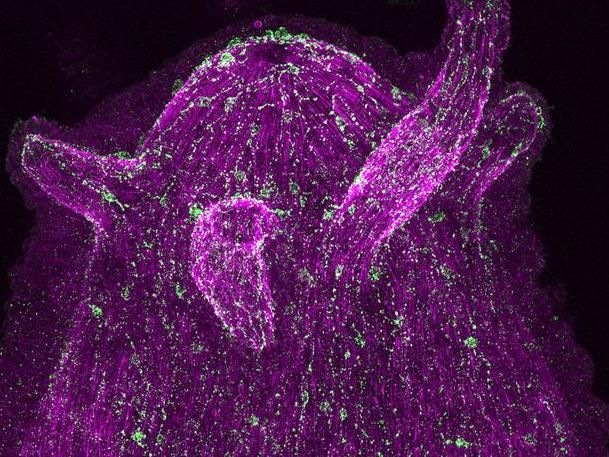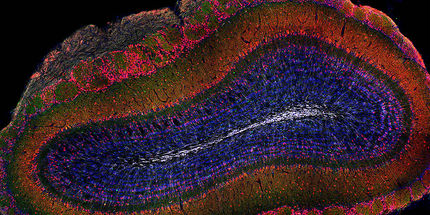Did nerve cells develop to talk to microbes?
CAU research team discovers that an ancient nervous system and symbiotic microorganisms communicate with each other
Advertisement
Various diseases of the digestive tract, for example serious intestinal inflammation in humans, are closely linked to disturbances in the natural mobility of the intestine. The role of the microbiome - i.e. the natural microbial colonisation of the digestive tract - in these rhythmic contractions of the intestine, also known as peristalsis, is currently the subject of intensive research. It is particularly unclear how the contractions are controlled and how the cells of the nervous system, which act as pacemakers, work together with the microorganisms. A research team from the Cell and Developmental Biology group at the Christian-Albrechts-Universität zu Kiel (CAU) has now succeeded in demonstrating for the first time, using the freshwater polyp Hydra as an example, that phylogenetically old neurons and bacteria actually communicate directly with each other. Surprisingly, the researchers discovered that the nerve cells exchange with the microorganisms via immune receptors, i.e. to a certain extent with the help of the mechanisms of the immune system. On this basis, the researchers of the CAU Collaborative Research Centre (SFB) 1182 "Origin and Functioning of Metaorganisms" formulated the hypothesis that the nervous system not only takes over sensory and motor functions from the very beginning of evolution, but is also jointly responsible for communication with the microbes. The Kiel researchers around Professor Thomas Bosch published their results together with international colleagues in the journal Proceedings of the National Academy of Sciences of the United States of America (PNAS).

A population of neurons in Hydra's diffuse nervous system expresses neuropeptides (in green), which are made visible by means of specific antibodies. The cell nuclei are stained in magenta.
Dr. Alexander Klimovich
Observations on a simple and ancient nervous system
The research team studied the simple nerve network of the phylogenetically ancient freshwater polyp Hydra. It is similar in function to the so-called enteric nervous system of vertebrates, which controls the functionality of the digestive tract. The researchers of SFB 1182 made two important observations. First, they succeeded for the first time in identifying those cells of the nervous system of Hydra that are responsible for the rhythmic contractions of the polyp. The key to this discovery was the close collaboration with a human medicine group led by Professor Mauro D'Amato of Monash University in Melbourne, Australia. In a large-scale study with sample material from patients suffering from Irritable Bowel Syndrome (IBS), the Australian researchers discovered genes that may be responsible for disturbances in human peristalsis. On this basis, Thomas Bosch's research team also searched Hydra for cells in which these genes are active. Surprisingly, the researchers from Kiel found them in a small group of nerve cells of this ancient nervous system. When they switched off these genes in Hydra, thus deactivating the proteins they encoded, this immediately led to a drastic reduction in rhythmic intestinal contractions. The CAU researchers were thus able to prove that these were indeed the pacemaker cells that control intestinal contractions. Since these gene variants were originally discovered in human samples of IBS sufferers, the Kiel researchers suspect that these neurons are central control units that were developed early in the evolution of animals to regulate complex body functions.
The study by the CAU research team also produced a second, equally surprising result. The detailed molecular genetic analysis of Hydra's individual neurons showed that they exert a direct influence on the density and composition of the symbiotic bacteria using the tools of the innate immune system. It was already known that the absence or disruption of the microbiome exerts a significant influence on the frequency and regularity of contractions. In addition, the new study now makes it clear that this is a phylogenetically ancient regulatory system in which the communication between certain neurons and the symbiotic bacteria plays a central role.
"Our observations indicate that the nerve cells are able to perceive microorganisms and react to them," explains Dr. Alexander Klimovich, scientist in cell and developmental biology and member of SFB 1182. "For this purpose, the neurons use receptors that are found in other animals in cells of the immune system," the first author continues. Activated pacemaker cells then release certain molecules such as antimicrobial peptides, which in turn have a strong influence on the presence or absence of certain microbes.
In subsequent investigations, the Kiel research team compared the control mechanisms of the hydras with those of nematodes and mice. They found that the cooperation of pacemaker cells and microbes can also occur in them. More detailed analyses showed that, for example, the pacemaker cells in the mouse intestine also possess immune receptors that communicate with the microorganisms in a similar way. "We therefore assume that the communication between neurones and microbes via immune receptors is an evolutionarily highly conserved property," Klimovich emphasises. "It is possible that this connection between the nervous system and the microbiome first developed in hydras a good 650 million years ago," says Klimovich.
A new hypothesis
The findings of the Kiel research team thus provide evidence that the nervous system was probably closely linked to symbiotic microorganisms from the very beginning. "We may have to rethink the evolution of the immune and nervous systems," emphasizes Professor Thomas Bosch, head of the Kiel Cell and Developmental Biology Department and spokesperson of the SFB 1182, "The investigations on Hydra show that even the oldest evolutionary nervous systems in nature interacted with microorganisms. It is possible that nerve cells were invented to enable communication with the microbes that are so important for the body," Bosch continues.
If this hypothesis is correct, it also opens up completely new perspectives on the development and future treatment of human intestinal diseases based on impaired intestinal mobility. This is because a correlation between the state of the microbiome and the disorders of intestinal mobility is very likely to exist in humans as well. "In the future, therefore, we must also consider the role of nerve cells in the development and treatment of inflammatory bowel diseases," Bosch predicts. The better the researchers understand their involvement in the development of the disease, the closer therapeutic interventions in the microbiome that could allow healthy intestinal mobility and thus the treatment of chronic intestinal diseases will come.
Note: This article has been translated using a computer system without human intervention. LUMITOS offers these automatic translations to present a wider range of current news. Since this article has been translated with automatic translation, it is possible that it contains errors in vocabulary, syntax or grammar. The original article in German can be found here.
Original publication
Alexander Klimovich, Stefania Giacomello, Åsa Björklund, Louis Faure, Marketa Kaucka, Christoph Giez, Andrea P. Murillo-Rincon, Ann-Sophie Matt, Doris Willoweit-Ohl, Gabriele Crupi, Jaime de Anda, Gerard C.L. Wong, Mauro D’Amato, Igor Adameyko, Thomas C.G. Bosch (2020): Prototypical pacemaker neurons interact with the resident microbiota PNAS First published on 09 July 2020


























































